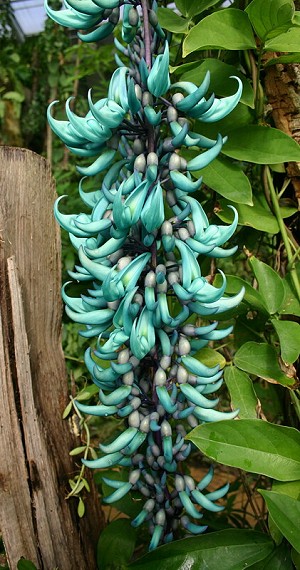
|
|
Jade
vine
- Strongylodon macrobotrys leaves and flower
|
Jade vine
- Strongylodon macrobotrys
The jade vine (Strongylodon macrobotrys) is a native of the tropical forests of the
Philippines. Its flowers are the color of jade, and hang in bunches up to 90 cm
long; each clawlike flower is about 7½ cm long. In its native Philippines, the jade vine's flowers are pollinated by
bats.
Jade vine is an evergreen twining vine with thick woody stems an inch or more in diameter and growing to 70 ft (21.3 m) or more in
length. The leaves are trifoliate with three oblong leaflets, each about 3-5 in (7.6-12.7
cm) long, the middle one largest. In spring and early summer jade vine bears bluish green claw shaped flowers 3-5 in (7.6-12.7
cm) long in huge hanging clusters up to 5 ft (1.5 m) or more in length. The inflorescence is truly
amazing. The cylindrical pea pods which follow are about 2 in (5.1 cm) long. The
pods are quite unlike the typical legume pod and contain up to 12 seeds.
S. macrobotrys is prized in tropical and subtropical gardens for its showy flowers which are a highly unusual
blue-green. It is usually grown over a pergola so that the flowers may hang down below where they can be seen
easily. In South Africa the jade vine is mainly restricted to the warm humid strip of coastal Natal but grows in a few
frost-free spots inland. The superficially similar red jade vine is in fact a species in a different
genus, namely Mucuna bennetti.
The aquamarine color of jade vine's flowers is nearly unique in the plant
kingdom. Hanging amidst lush tropical foliage, the flowers are practically
luminescent. Jade vine is cultivated in Hawaii for the flowers which are used in
leis.
The common name is derived from the purple color of the seed
pods. Other English names include Gray's jade vine (after Asa Gray [1810-1888], the American botanist who described and named this vine in 1854) and emerald
creeper.
The jade vine actually belongs to the pea family (mame-ka, Leguminosae). It has some 27 recognized
species, naturally distributed from Madagascar across the islands of the Indian
Ocean, including Sri Lanka, New Guinea and the Philippines. The generic name,
Strongylodon, comes from strongylos, the ancient Greek word meaning round, and
odous, a tooth, referring to the rounded teeth found on the flower's calyx. The species
name, macrobotrys -- "large grapelike clusters" -- refers to the seeds'
appearance.
The jade vine is pollinated in the wild by
bats. The bats hang upside down to sample the jade vine’s nectar, and the plant gently brushes pollen onto the bat’s head while it
drinks. The next plant the bat visits collects the pollen from the first before brushing its own pollen to be transported
elsewhere. It is a great example of co-evolution in action: the plant and the bat have evolved to work perfectly in cooperation with each
other.
In its natural habitat, ñestricted to the rainforests of the Philippines (Luzon, Mindoro and Catanduanes
Islands), S. macrobotrys is in great danger of extinction. The vine only grows in the
deepest, darkest tropical rain forest, which is being felled for timber. The rainforests of the Philippines are disappearing at an alarming rate – originally the islands were almost completely
forested, but a 1988 survey estimated that only 20 per cent of the forest
remained. The speed at which the rainforest is vanishing adds a sense of urgency to Kew's research into the jade vine’s floral
biology.
Source:
http://en.wikipedia.org/wiki/Jade_vine
http://www.floridata.com/ref/S/stro_mac.cfm
http://250.kew.org/Plants/KEW_050358.html
http://search.japantimes.co.jp/cgi-bin/fe20000927a1.html
